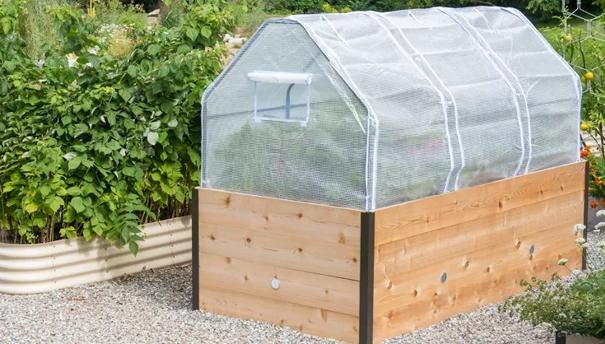Late blight, a disease that strikes tomatoes and potatoes, can quickly ruin an entire crop — and infect other plants as well. It is critical that gardeners understand that late blight is not like other tomato and potato diseases. Many other diseases affect these crops in home gardens, but most of them only affect leaves or cause limited damage to fruit, and while they may reduce the harvest, they generally don't cause a total loss. In the last few years, late blight has become a major threat to both home gardeners and commercial growers. It's important for gardeners to be aware of this disease so they can act quickly.
 Fuzzy growth on the underside of a tomato leaf indicates that the late blight fungus is growing and producing spores.
Fuzzy growth on the underside of a tomato leaf indicates that the late blight fungus is growing and producing spores. Late blight stem lesions
Late blight stem lesionsFurthermore, because most pathogens are not readily dispersed by wind, their effects are localized. Late blight, on the other hand, kills plants outright, and it is highly contagious. Its occurrence in your garden can affect other gardens and farms due to the wind-dispersed spores.
The fungus, (Phytophthora infestans), that causes late blight is aptly named: phytophthora in Latin means "plant destroyer." Infected plant tissue dies. Outbreaks spread quickly under favorable conditions (cool, wet weather) because the pathogen can produce huge numbers of wind-dispersed spores. Once a plant is infected, it must be destroyed.
 Commercial growers use Serenade Garden Disease Control to control foliar diseases. It is so safe you can spray and harvest the same day.
Commercial growers use Serenade Garden Disease Control to control foliar diseases. It is so safe you can spray and harvest the same day.Be Prepared
The USA Blight web site tracks the occurance of late blight in real time. Check the site regularly during the growing season. When late blight is detected in your region, consider a weekly prevetative spray.
Cornell plant pathologist Meg McGrath suggests using Actinovate (which contains the beneficial bacteria Streptomyces lydicus) as a preventative spray, and adding a copper-based product when late blight is present.
Remember that while these sprays can help reduce the likelihood of infection, you still need to monitor plants closely.
Five Tips to Prevent Late Blight
Unfortunately, there's no silver bullet for control. The key is to plant wisely, be prepared, be alert and learn to distinguish late blight from other common diseases.
- Choose the right variety: Though no tomato varieties are completely immune to late blight, plant breeders are now developing varieties that are resistant to infection by the late blight fungus. So, when it's time to decide which varieties to plant, keep an eye out for these. If you can, start your own plants from seed or buy transplants from a trusted local source. You might also want to plant some varieties that mature early so if late blight does strike, you may still get a harvest.
- Prevent overwintering: Fortunately, the fungus that causes late blight needs living tissue to survive over the winter, so it can't overwinter on tomato cages or supports. However, infected potatoes (the other plant that gets late blight) can carry the disease through the winter. Be sure to destroy any volunteer potato plants that come up. If you plant potatoes again, be sure to buy seed potatoes that are certified as disease-free.
- Give plants space: If possible, avoid planting tomatoes and potatoes where you had them last year. Be sure to give plants plenty of space, based on recommendations for the variety. Maximizing airflow and light around the plants will help them resist disease. Make use of trellises and supports that will keep the vines off the ground.
- Avoid watering from above: Using soaker hoses or drip irrigation keep foliage dry, which makes it more difficult for late blight — and other diseases — to spread. Avoid overhead watering techniques (sprinklers). Water early in the day so the foliage can dry before nightfall.
- Pay attention to the weather: Learn to recognize the weather conditions that foster the spread of late blight. The disease spreads rapidly in cool wet weather, whereas dry weather tends to hold back the disease. The USA Blight website tracks the occurence of late blight in real time. Check the site regularly during the growing season. Your local cooperative extension may be a good source of information, too. Stay in touch with gardeners in your area so you'll know right away if late blight is near. When late blight is detected in your region, consider preventative spraying.
Is it Late Blight, Septoria Leaf Spot, or Drought Stress?
Make sure you know what late blight looks like. Draught stress and two other diseases look similar but unlikely to kill your plant. The images at right can help you distinguish them.
- Early blight: symptoms first appear on older leaves near the base of the plant. Note the "target" appearance of concentric rings.
- Septoria leaf spot: Symptoms of this disease usually first appear on the oldest leaves, after fruit start to ripen.
- Drought stress: This physiological injury can be distinguished from late blight by the lack of the fuzzy, spore-producing growth and the lack of stem lesions.
Take Action Once You Spot Late Blight
If treated plants show signs of continuing infection or if unsprayed plants succumb to late blight, take action immediately:
- Pull up the plants and either seal them tightly in a trash bag, or secure them under black plastic, where the sun's heat can kill the spores.
- Do not compost blight-infected plants.
If left unattended, the disease will spread quickly from your plants to those of your neighbors and local farmers. Please, garden responsibly!
Additional Resources
- USA Blight: An information portal on late blight. You can report disease occurrences, submit a sample online, observe disease occurrence maps, and sign up for disease alerts. There are also links to more information about identification and management of the disease.
- Late blight on tomatoes: From Margaret McGrath, Cornell University
- Late blight on potatoes: From Margaret McGrath, Cornell University
- Cooperative Extension services: Find cooperative extension services and master gardeners in your area.







